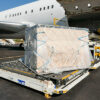How Container Ships Have Changed Over the Decades
Shipping has been around in many forms for thousands of years - camels, horses, wagons, trains, cars, trucks, planes, boats, and now even drones. Cargo was loaded as goods in barrels, baskets, or crudely built crates and then moved from one place to another. The odd sizes and shapes of the items often made for an inefficient load with a lot of wasted space, and the goods could be easily damaged.
It was not until a man named Malcom McLean, originally a truck driver, developed a new method of shipping goods via boat. This new way was by using containers, specifically trailer vans, like the ones from his trucking business. In 1955, he purchased and retrofitted a WWII tanker to carry the containers on the deck. By using these rectangle-shaped trailer vans, goods could be organized neatly on the boat with little wasted space, and products protected inside the containers. In 1956, the first sailing of this ship, which Mr. McLean named SS-Ideal X, began from Newark, New Jersey, around the tip of Florida, to Houston, Texas. The Ideal X was carrying 58 trailer vans, so 58 TEU, or Thirty-foot Equivalent Units. A ship's cargo capacity varies based on the number of containers, but it is also dependent on the weight of the goods as well.
Today the trailer vans are called Intermodal Containers, a standardized shipping container designed for transport by boat, truck, or train and switched to a different mode without needing to be repacked. This standardization of the containers used has led to a significant decrease in handling time.
Has the cargo ship changed since the 1950s? While Mr. McLean's idea was the beginning of the modern cargo ship and earn him the nickname "Father of Containerization," today's cargo ships look a bit different than they did at the start.
1960-1970s –
The success of McLean's ship led to more ships converted to hold containers. The use of onboard cranes to load and offload cargo was common because ports did not need cranes yet. Many ports didn't have dock-side cranes built until around the 1970s. Ships were now able to carry cargo below deck as well, increasing capacity to up to 2,500 TEU.
1980-1990s –
The 1980s was a period that saw the production of much larger cargo ships. The industry knew that the more containers you could get onto the ship, the more profit they would make on each trip. One thing that constrained the design was the dimensions of the Panama Canal, a heavily used shipping route. The established width of the canal's locks meant that they increase the length of a ship, but not the width. The maximum ship width became known as the Panamax Standard.
In 1988, with the increase in global trade due to containerization, there were ships built for other routes that did not include a pass through the Panama Canal. These ships were made wider than the Panamax Standard and were called Post Panamax. The Post Panamax had a capacity of 4,000 – 6,000 TEU.
There was one issue with Post Panamax ships, however. They were built taller, and once loaded, the buoyancy would require a deeper waterway to reach ports. While the additional cargo area lowered shipping costs per voyage, it meant some ports would need to dredging to accommodate them. Dredging is an intentional reshaping of a waterway, in this case, to make the water levels deeper. Even today, ports dredge to keep up with these ships and for maintenance.
2000s –
In 2000, the Post Panamax II debuted with even more cargo capacity than its predecessors. The ability to transport 6,000 – 8500 TEU meant that this ship could hold around 100 times more than the McLean's SS-Ideal X did in 1956.
2010s -
In June of 2016, a Panama Canal expansion project was completed. The promise of this expansion led to new ship designs to take advantage of the canal's new dimensions. These ships are called New- Panamax and have a capacity of up to 12,500 TEU.
Think these cargo ships couldn't get any larger? Nah, of course they can! The next generation of cargo ships is called Very Large Containership and Ultra Large Containership. As these names imply, they are massive, with capacities of up to 14,500 TEU. So large, in fact, that they won't fit through the recent Panama Canal expansion, so the VLC's and ULC's sail other routes that don't include the canal.
2020s –
The future of containerized shipping seems to hold even more change. There are ships in design phases that have capacities of up to 30,000 TEU, an astonishing number when compared to the McLean's first sailing of only 58 containers. Also on the rise are autonomous vessels. With the addition of technology, artificial intelligence, and machine learning, designers are working to see ships with little to no human interaction transport cargo either by remote operators or even on an auto-pilot program. These ships would have less crew on board – or even no crew, which could be a cost savings for shippers. It's early to say if that savings is worth the risk of having crewless ships in their fleet.






